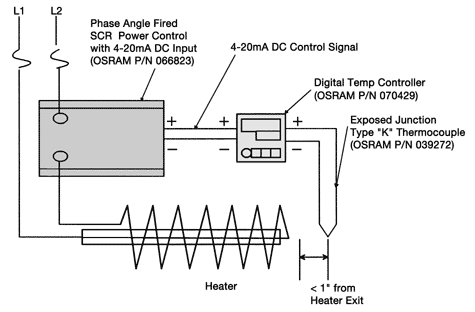Using an Air Heater
If used properly, heater life of 5000 hours or greater can be expected. To ensure long heater life and safe operation, follow these guidelines. Also read and understand your heater Operating Manual before use. Failure to follow these guidelines can result in heater damage, failure, or personal injury.
Air Sources
In general, compressed air, and air from regenerative blowers may be used to supply Osram Sylvania air heaters. Your air source should be clean and dry. Dirt, grease, oil, or oil vapors, or corrosive or reactive gases will damage an air heater. Also, use air or inert gas only. Do not use with volatile or combustible gases.
Regenerative blowers
Regenerative blowers are compact and inexpensive clean air sources. They can provide large amounts of low-pressure air for your air heating system. Blower size is based on the maximum amount of airflow (CFM or LPM) it can produce without any inlet or exit restrictions. When a heater or other restriction is attached to a blower, the maximum flow decreases. If the blower is severely restricted, the blower motor can overheat and fail.
When designing your heating system, you should try to minimize air restrictions, and select a blower sufficient to overcome the backpressure generated by the heater, flare, and associated piping. Because of their small size, the Series, Hot Air Tool, and Serpentine II heaters should not be used with regenerative blowers.
Compressed Air
Compressed air is commonly available in most factories. It is high-pressure regulated air (typically to 100psi), and often contains oil for lubricating pneumatic valves and equipment. You must filter this oil to prevent fouling and damage to Osram Sylvania's electric air heater elements.
When measuring compressed air flow rates, be sure you are measuring Standard CFM or Standard LPM units. The "Standard" means that the units are measured at standard temperature and pressure. Many flow meters are labeled SCFM, but this is incorrect at the higher pressures produced by compressed air. For accurate flow measurements, you must consult your flow meter manual for converting CFM to "Standard" CFM. In the diagram below, the flow meter reading (CFM) is converted to SCFM using a Dwyer ball-type flow meter conversion.

Controls
A good control system is critical for long heater life. Before turning your control system on, you must have sufficient airflow through the heater before applying power. (Applies to heaters without SureHeat or Hot Air System over-temperature protection.) Only qualified individuals should install Osram Sylvania heaters and controls. Follow all applicable electrical codes and use proper wiring.
Open-Loop (Manual) Control
This simple method of control uses a manually operated power controller to apply a fixed voltage to the heating element. Using this system, the operator manually adjusts the controller to change heater temperature. Note that if the airflow is suddenly interrupted, the element could fail. The open-loop controller is generally used with Osram Sylvania’s Series heaters.
Closed-Loop (Feedback) Control
A closed-loop heater control system uses a power controller, temperature controller, and thermocouple to provide a constant output temperature, regardless of changes in airflow. The temperature controller also provides a convenient display of your process air temperature.
Power Controller
Phase angle fired SCR (Silicon Controlled Rectifier) power controls will provide the smoothest power regulation for Osram Sylvania Air Heaters.
Other power controls may be suitable, such as distributive zero cross SSR (Solid State Relays) or other fast-switching SSR’s, but you should contact Osram Sylvania for approval before use.
Temperature Controller
Use only digital temperature controls with type-K thermocouple inputs. The temperature control output must match the input of the power control. (i.e. 4-20mA, or 0-10VDC).
A standard PID-type control with a wide proportional band setting will work best to minimize temperature overshoot. PID parameters may be auto-tuned, but only at temperatures well below the maximum of the heater. If the temperature rises too high during auto-tune, turn power off immediately.
When using a Solid State Relay power control, the temperature controller cycle time should be set for 100ms or less.
Thermocouple
Use only a fine-wire (.030" max wire dia.), exposed-junction, type-K thermocouple placed within 1" of the heater exit for accurate temperature readings. Other thermocouple styles, or varying the distance from the heater exit will result in temperature measurement errors and/or heater failure.

|